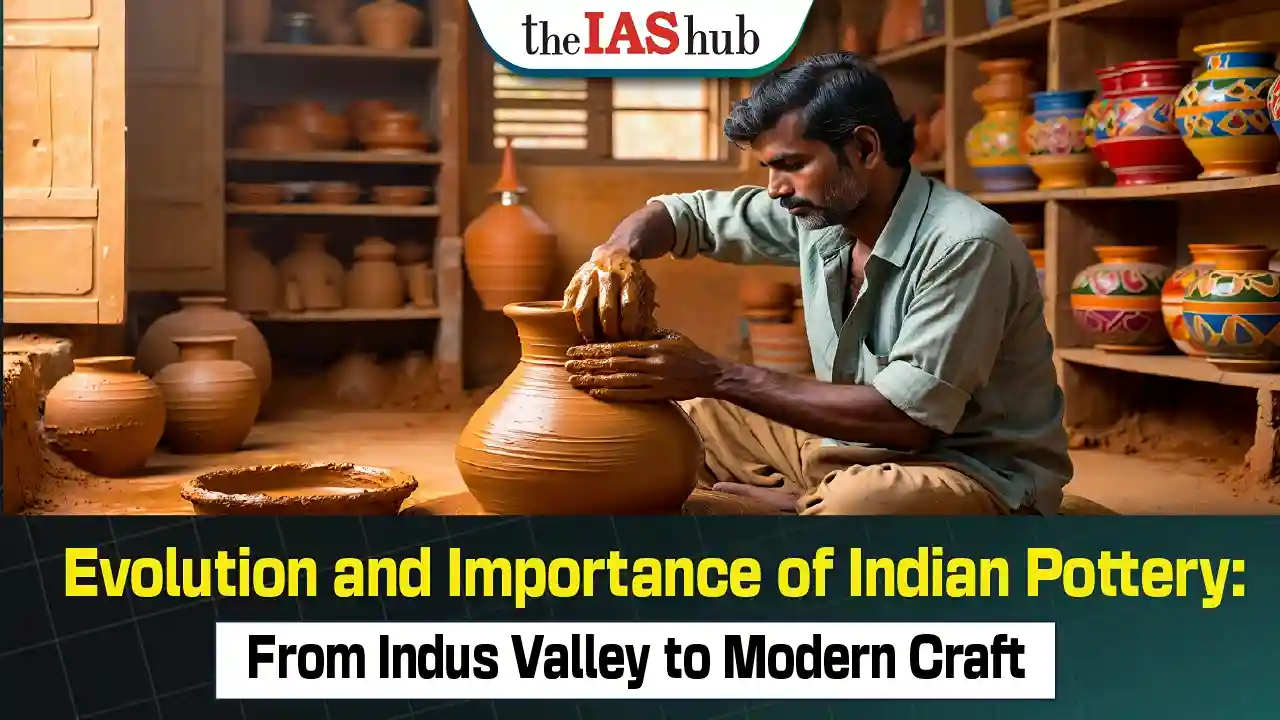In the early villages of Mehrgarh, pottery from the Indus Valley Civilization (3300 BCE– 1500 BCE) has been found. In India, this cultural art form is being actively practised today. In the study of culture and the reconstruction of the past, pottery is important.
Evolution of Indian Pottery
Neolithic Age
- Pottery or ceramic ware emerged in the Neolithic period and became more advanced in the post-Neolithic era, spreading across the globe.
- The shaping of pots can be achieved through handmade or wheel-made techniques, while decorations and paintings, ranging from geometric to naturalistic designs, can be applied before or after firing.
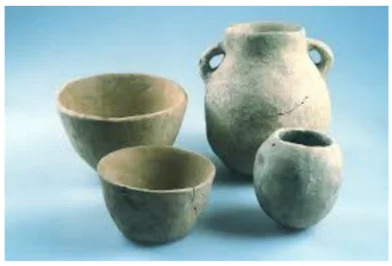
Chalcolithic Period
- Malwa ware: A characteristic pottery type of Malwa Chalcolithic culture. It is a wheel made pottery with buff or cream slip and has painted patterns in dark brown or black colour.
- Painted Grey Ware (PGW): It is a characteristic pottery of early Iron Age in India, the other being NBP. This is produced from well-levigated clay and on a fast wheel. A thin slip is applied on both surfaces and the vessels baked at 600° C under reducing conditions producing the smooth ashy surface.
- Northern Black Polished ware (NBP): This is made on a fast wheel from well-levigated clay, well-baked with a blackish-grey and occasionally reddish core, and is thin and sturdy. Its distinctive feature is its glossy surface with mirror effect.
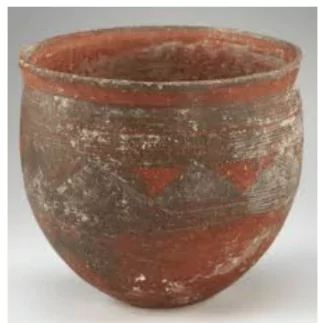
Pottery of the Indus Valley Civilization
- The characteristic pottery is black and red ware with black painted designs.
- The most popular design is a series of intersecting circles.
- The other common types are plain ware and plain red ware, both glazed and unglazed.
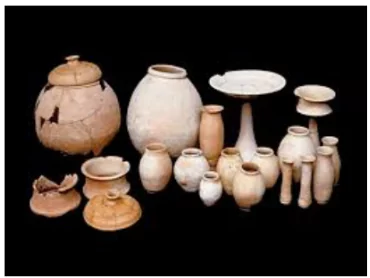
Iron Age Pottery
- Iron technology in South Asia including India is primarily associated with late prehistoric or early historic cultural periods.
- Archaeologically, Painted Grey Ware culture of Northern India is considered as iron using group in the sub-continent.
- In Northern India, Painted Grey Ware and Northern Black Polish were the earliest Iron Age cultures; at some sites, a pre-Painted Grey Ware known as Black and Red ware is said to mark the beginning of Iron Age.
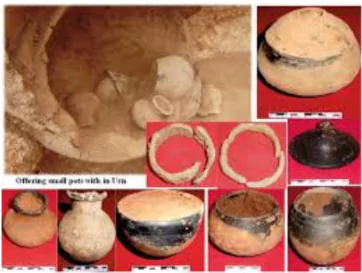
Painted Grey Ware (PGW)
- PGW is a very fine ware, fired under reducing condition, which gives it a grey colour.
- PGW is usually associated with cultures of rural areas.
- PGW was first discovered in Ahichchatra in 1944.
- Over 400 sites have been discovered in Ravi-Sutlej basin, Ghaggar basin and Ganga-Jamuna Doab. Important excavated sites of PGW are Hastinapur, Ahichchatra, Alamgirpur, Atranjikere, Noh, Jodhpur, Bhagwanpur, Indraprastha, Kurukshetra, Panipat and Tilpat.
- PGW people were agriculturists with cattle breeding as their principal occupation.
- They domesticated the cow, buffalo, pig, goat, sheep and horse.
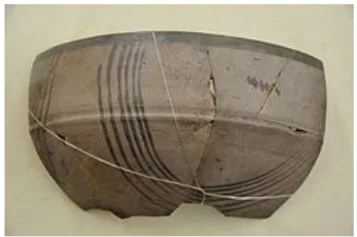
Northern Black Polish Ware (NBPW)
- NBP is made on a fast wheel from well-levigated clay, and it is well baked.
- The quality of NBP is quite remarkable. Its distinctive feature is the glossy surface with mirror effect.
- NBP is usually associated with cultures of cities.
- NBP saw emergence of cities and the first political entities known as Mahajanapadas in the Ganga plains in the 6th century BCE.
- This was the location of the second major Hindu epic, Ramayana and the rise of Buddhism and Jainism.
- This period witnessed the second urbanisation.
- NBP is seen throughout Northern India but its main occurrence is in the Ganges plains in Uttar Pradesh and Bihar.
- It is found in small quantities in Central, Southern and Eastern India, as well as Bangladesh and Sri Lanka. This pottery was probably carried off to far places by Buddhist monks and high officials.
- Mauryan Period: The ceramic wheel gained popularity. Ceramics from the Mauryan era come in a wide variety of styles. The most sophisticated method, however, may be seen in a type of pottery called Northern Black Polished Ware (NBP), which was well-liked in the earlier and early Mauryan times.
- Kushana Period: The Kushan cultural epoch in Bengal and North India brought about a new era in pottery. This phase's pottery is characterised by a characteristic red polished ware with stamped design as well as a sizable amount of dull or strong redware.
- Guptas Period: Remains of Gupta pottery found in Ahichchhatra, Rajgarh, Hastinapur, and Bashar are remarkable examples of their ceramic prowess. The most recognisable style of pottery from this era is redware.
- Mughal and Rajput Period: Glazed pottery with Persian and Indian designs are found in Gujarat and Maharashtra and date to the Sultanate era. Modern Jaipur's Blue Pottery is frequently regarded as a traditional Jaipur craft.
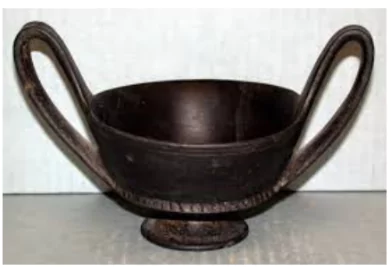
Importance of Pottery
- Cultural Importance: Pottery reveals past cultures. Historically, Style changes with distinct cultures. It reflects social, economic and environmental conditions. Also, Helps understand history.
- Social Importance: Pottery provides insights into the use of fire, cooking, storage, and trade. It reflects the lifestyle and settlement patterns of ancient societies. Pottery evolves into an artistic form of expression. It helps in understanding social stratification and societal organization.It reveals the belief in gods and deaths.
Recent Government Developments in Pottery
- ASI prepares third season excavation at Purana Qila, Delhi. Led by Shri Vasant Swarnkar. Earlier campaigns found artifacts such as painted grey ware (900 BC) to pottery from various periods like the Maurya, Shunga, Kushana, Gupta, Rajput, Sultanate, and Mughal periods.
- Keeladi in Tamil Nadu reveals ancient urban civilization. Excavations show pottery industry.
- India, which has the largest craft concentration in the world, has only 2% of the global handicraft market share (Business Economic 2020).
- “Industhan’s passive cooling tiles, which are made by adding small quantities of rejected and broken pieces of sinks and toiletware.
- The Manamadurai pottery recently earned a Geographical Indication (GI) tag.
- A unique type of clay is sourced from water bodies like Nedunkulam, Nathapurakki, Sundaranadappu, Seikalathur to make these pots.
- While making these pots, the five elements of nature namely earth, water, fire, sun and air are used.
- ASI finds Kushan and Gupta pottery at Unnao fort excavation at the dilapidated fort of Raja Ram Baksh Singh at Unnao in Uttar Pradesh.
Way Forward
- E-commerce: In addition, as the industry develops and receives more traction, leveraging e-commerce for online visibility and operational efficiencies will show to be a crucial success factor.
- Enhance conditions of craftsmen: The government has already made enormous achievements by enacting policies that would make handcraft items competitive globally and enhance the conditions of our craftsmen, notwithstanding the precarious state of artisans needing attentive interventions for their uplift.
Conclusion
In the study of culture and the reconstruction of the past, pottery is important. Pottery has changed over time in response to various civilizations. It depicts the social, economic, and environmental circumstances in which civilization arose and developed, assisting historians and archaeologists in understanding our past.
